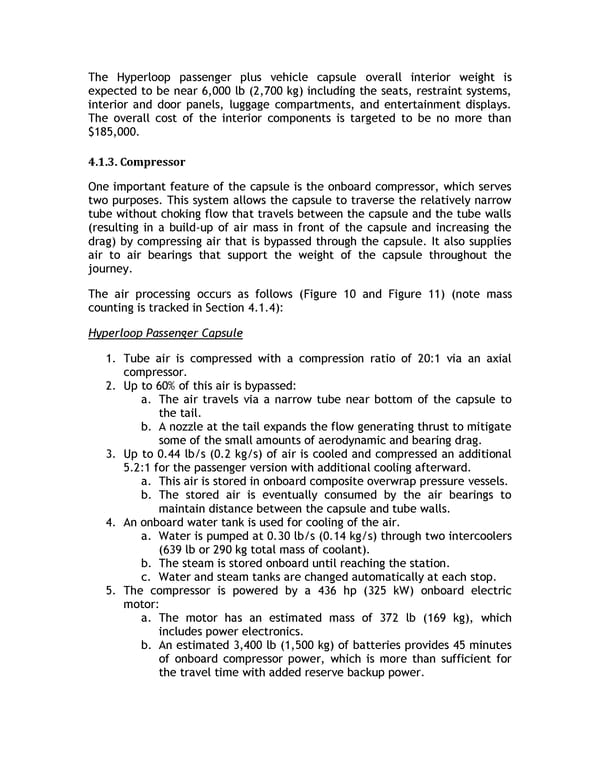The Hyperloop passenger plus vehicle capsule overall interior weight is expected to be near 6,000 lb (2,700 kg) including the seats, restraint systems, interior and door panels, luggage compartments, and entertainment displays. The overall cost of the interior components is targeted to be no more than $185,000. 4.1.3. Compressor One important feature of the capsule is the onboard compressor, which serves two purposes. This system allows the capsule to traverse the relatively narrow tube without choking flow that travels between the capsule and the tube walls (resulting in a build-up of air mass in front of the capsule and increasing the drag) by compressing air that is bypassed through the capsule. It also supplies air to air bearings that support the weight of the capsule throughout the journey. The air processing occurs as follows (Figure 10 and Figure 11) (note mass counting is tracked in Section 4.1.4): Hyperloop Passenger Capsule 1. Tube air is compressed with a compression ratio of 20:1 via an axial compressor. 2. Up to 60% of this air is bypassed: a. The air travels via a narrow tube near bottom of the capsule to the tail. b. A nozzle at the tail expands the flow generating thrust to mitigate some of the small amounts of aerodynamic and bearing drag. 3. Up to 0.44 lb/s (0.2 kg/s) of air is cooled and compressed an additional 5.2:1 for the passenger version with additional cooling afterward. a. This air is stored in onboard composite overwrap pressure vessels. b. The stored air is eventually consumed by the air bearings to maintain distance between the capsule and tube walls. 4. An onboard water tank is used for cooling of the air. a. Water is pumped at 0.30 lb/s (0.14 kg/s) through two intercoolers (639 lb or 290 kg total mass of coolant). b. The steam is stored onboard until reaching the station. c. Water and steam tanks are changed automatically at each stop. 5. The compressor is powered by a 436 hp (325 kW) onboard electric motor: a. The motor has an estimated mass of 372 lb (169 kg), which includes power electronics. b. An estimated 3,400 lb (1,500 kg) of batteries provides 45 minutes of onboard compressor power, which is more than sufficient for the travel time with added reserve backup power.
 Hyperloop Alpha Page 16 Page 18
Hyperloop Alpha Page 16 Page 18